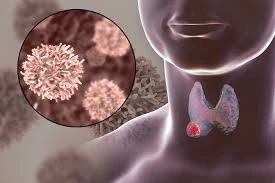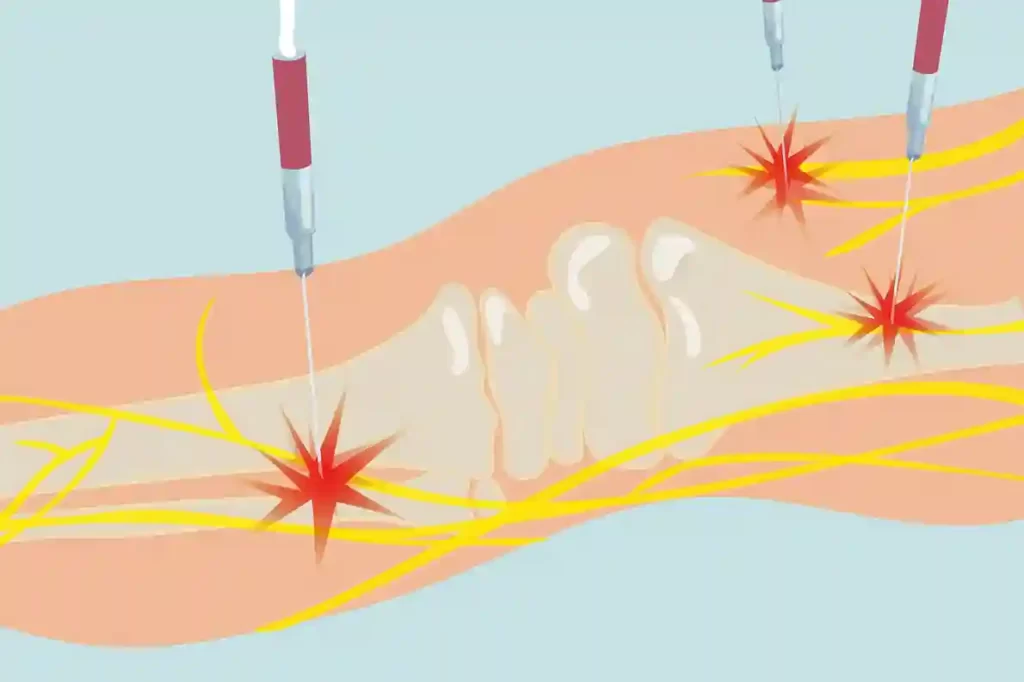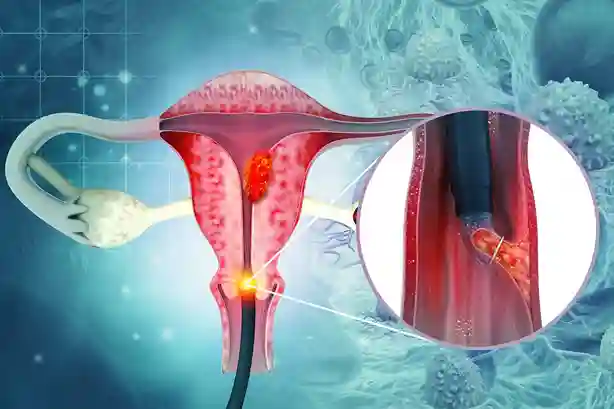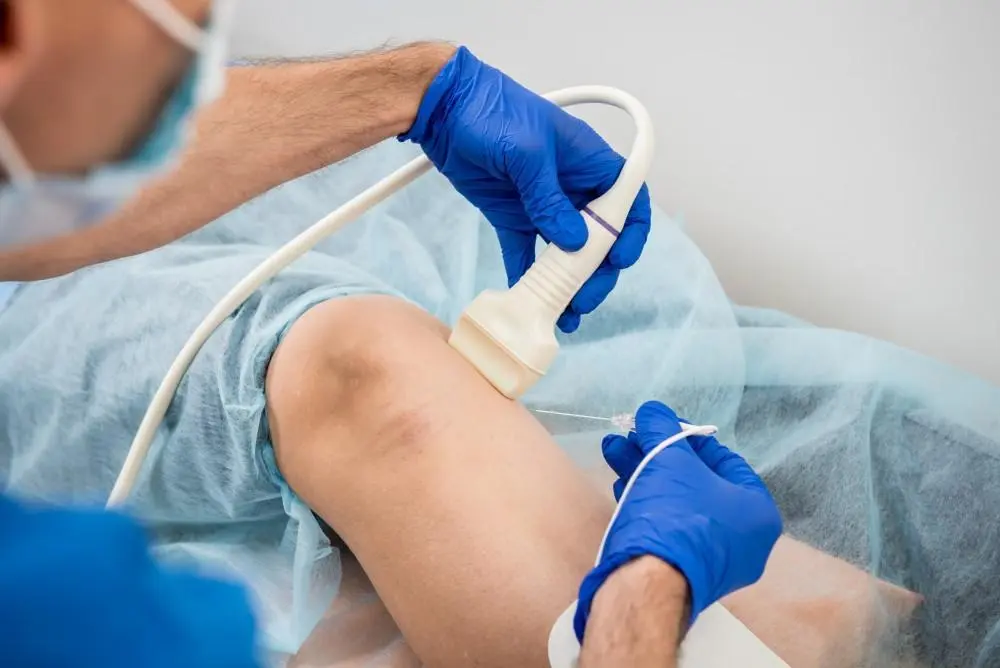Radiofrequency Ablation (RFA)
Introduction
Radiofrequency ablation (RFA) uses heat to remove tissue. To manage pain, radio waves are transmitted through a carefully positioned needle to raise the temperature of a specific nerve region. This stops pain signals from being sent back to the brain. RFA is an option for chronic pain conditions, particularly those affecting the neck, lower back, or arthritic joints.
What does radiofrequency ablation mean?
Radiofrequency ablation is a procedure for managing pain, mainly aimed at arthritis or spinal joint pain. These joints have small sensory nerves that only inform the brain about the joint’s condition. These nerves are the primary source of pain signals originating from the joints in the back.
A pain medicine physician performs radiofrequency ablation by positioning specialized needles over the affected nerves and transmitting thermal energy or heat signals through these needles. This causes a temporary disconnection of the nerves. Although it doesn’t address the pain’s root cause, radiofrequency ablation reduces the quantity of pain signals originating from the joints. For the majority of patients, it results in relief of back pain.
What does radiofrequency ablation (RFA) involve?
Radiofrequency ablation (RFA), also known as radiofrequency neurotomy, uses radio waves to generate a current that raises the temperature of a small region of nerve tissue. The heat eliminates that portion of the nerve, preventing it from relaying pain signals to your brain. For individuals suffering from chronic pain, particularly in the lower back, neck, and arthritic joints, RFA can offer long-lasting relief.
Purpose of radiofrequency ablation (RFA)
Radiofrequency ablation aims to:
- Stop or lessen pain.
- Enhance function.
- Lower the quantity of painkillers used.
- Prevent or postpone surgery.
Mechanism of radiofrequency ablation
Radiofrequency ablation targets diseased tissue using heat generated from radio waves. Applying radiofrequency to nerve tissue causes nerve damage, which impacts or stops the transmission of pain signals to the brain and leads to pain relief.
In the course of a radiofrequency ablation procedure, a small, hollow needle is placed into the nerve that is targeted as the source of pain. An electrode is placed at the needle’s tip, transmitting radio waves through the needle to reach the targeted nerve. The heat creates a lesion that stops the nerve from transmitting pain signals to your brain. The procedure does not harm nearby healthy nerves.
Pain management within your spine
Radiofrequency ablation is frequently used to locate pain that arises from joints (like your knee) and is often associated with spinal pain, particularly from your neck and lower back (lumbar region).
- Nerves branch off from your spinal cord within your spine and extend to the facet joints and sacroiliac joints.
- Facet joints are small paired joints located between the vertebrae of your spine. Your spine can twist and bend thanks to these joints, which provide flexibility and enable back movement. Two small nerves known as medial branch nerves are linked to the facet joints and transmit signals to your brain, indicating that pain is originating from these joints.
- The sacroiliac joints are located at the lower end of your spine, directly above your tailbone. The lateral branch nerves linked to these joints transmit pain signals from the spine to your brain.
Treating the targeted medial branch nerve in the facet joints or the lateral branch nerve in the sacroiliac joints with radiofrequency ablation reduces the pain signals that reach your brain.
In what way do you have RFA?
Before the start of treatment, you have either:
A general anesthetic open glossary item, a sedative to induce sleepiness, and a local anesthetic to numb the region. You will also receive strong painkillers during treatment.
- There are various methods for obtaining RFA. The most frequent method is via your skin (percutaneously). It can also be administered during surgery. The surgeon would use needle electrodes to treat your cancer through the incision during the operation.
- Once you have had an anesthetic, you will undergo either a CT scan or an ultrasound scan. Your surgeon or radiologist opens a glossary item and uses the scan to guide a needle, measuring 1 to 2 millimeters in width, through your skin and into the tumor. If there is a large tumor or multiple tumors, your surgeon may need to use several RFA needles.
- Your surgeon can adjust the heat based on your cancer’s size. The duration of this varies. The total time can vary from 30 minutes to a few hours.
You are monitored by nurses during the entire procedure. Your blood pressure, pulse and oxygen levels are monitored by them. If you experience pain, you can have additional pain relief. When the treatment is complete, your doctor will take out the needle and cover the area with a dressing.
It is usually necessary to stay overnight in the hospital. However, in some cases, it is possible to receive outpatient treatment and return home the same day.
Who can have RFA?
Typically, RFA is not the primary cancer treatment. If you have the following, you might receive RFA alone or alongside other treatments:
- Primary liver cancer
- Secondary liver cancer
- Primary lung cancer
- Secondary lung cancer
- Kidney cancer
- Neuroendocrine cancer
- Secondary bone cancer
If surgery isn’t an option for treating your cancer, your doctors may suggest RFA. The following factors may be included for this:
- You have multiple tumors.
- Surgery is complicated by the cancer’s location (for instance, if it is adjacent to a major blood vessel)
- A general anesthetic is not an option for you.
It has been discovered by researchers that RFA is most effective on small cancers, typically those with a diameter of less than 3 cm. However, physicians occasionally uses RFA for treating larger tumors. It is possible to undergo RFA treatment multiple times.
If you have secondary bone cancer, you might undergo RFA to relieve symptoms like pain. This would be available at specialist centers, so you might need to travel for treatment.
Procedure
Before a radiofrequency ablation (RFA) procedure
Your healthcare provider will assess your medical and medication history and inquire about your pain. If you are using aspirin or other anticoagulant medications, it may be necessary to discontinue them for a few days before the procedure.
Your provider will assess you and request X-rays or other imaging tests usually necessary to visualize your anatomy, evaluate the extent of arthritis or other spinal injuries, and remove any alternative explanations.
A diagnostic block test will be conducted by your provider to verify the origin and intensity of your pain, allowing for a prediction of the potential extent of your pain relief. The block involves administering a local anesthetic close to the painful area. Should the diagnostic block fail to produce considerable relief, RFA may not be advantageous for you. Your provider may suggest RFA as a pain-relief treatment if you respond positively to the diagnostic block.
During a radiofrequency ablation procedure
You will start by lying on your stomach on a special X-ray table. Throughout the procedure, your healthcare provider will observe your condition using monitors. You will stay aware, allowing you to respond to your provider’s questions throughout the procedure. You may be given medications during the procedure to help you relax, but this is optional.
Your physician will apply a local anesthetic to numb the skin area where a needle will be inserted. Subsequently:
- A slender needle is placed in the zone of your pain sensation.
- A special type of real-time continuous X-ray known as fluoroscopy guides needle placement.
- After the needle arrives at the target location, your physician will conduct a test to verify that it is correctly positioned. The test requires inserting a microelectrode via the hollow needle. Your physician will inquire whether you experience a tingling sensation (Pain or muscle twitch). This signifies that the appropriate place for treatment has been identified.
- A local anesthetic is administered via the needle to numb the area of interest.
- The identified part of the nerve is heated by sending a radiofrequency current through the needle.
- The current eliminates that section of the nerve, preventing it from transmitting pain signals to your brain.
During the procedure, it is possible to treat multiple nerves (if necessary).
After a radiofrequency ablation procedure
Following your radiofrequency ablation procedure:
After your procedure, you will go home shortly. You require someone to take you home.
Have a rest when you are home. For 24 hours following the procedure, avoid driving and any strenuous activity. After a day or two, you can resume your usual activities, such as bathing or showering.
For several days, you may still experience soreness, pain, or muscle spasms at the site of treatment. Your healthcare provider might have recommended pain relief medication for the soreness and pain. During the first day of your recovery at home, you can apply an ice pack to the injection site intermittently for 20 minutes several times.
Your provider might have also suggested physical therapy to recover strength and flexibility. Additionally, you will have a follow-up appointment to assess your progress and address any questions you may have.
Which conditions can radiofrequency ablation treat?
- Chronic pain resulting from conditions such as spinal arthritis (spondylosis) and sacroiliac (SI) joint pain.
- Pain in your neck, back, and knees.
- Pain from cancer.
- Facial pain due to trigeminal neuralgia.
- Pain in the peripheral nerves.
- Problems with the cardiac cycle.
- Malignancies (to remove cells).
Radiofrequency Ablation for Thyroid

Until a short time ago, the conventional treatment for thyroid nodules involved open surgery. In certain cases, doctors can use RFA as a treatment for them.
Individuals who have thyroid nodules and symptoms can talk to their head and neck surgeons about this possibility. Due to other health issues, some individuals are not suitable candidates for open thyroid nodule surgery. Some other suitable candidates may opt for RFA due to its reduced recovery duration in comparison to the usual recovery period associated with general anesthesia and open surgery.
- In case you and your physician conclude that RFA is suitable for treating your thyroid nodule, you will have one or several fine-needle aspiration biopsy procedures to confirm the nodule’s benign nature.
- Following that test, your physician will inform you of your eligibility for RFA. You should realize that, since the procedure does not remove the nodule, future ultrasounds of your thyroid will be necessary.
- For the majority of patients, RFA is suitable only for benign (noncancerous) nodules. RFA could be suitable for treating small tumors in certain contexts and with anxious monitoring.
- After RFA, the majority of patients feel normal within a day. Some individuals may observe minor bruising or tenderness, which is effectively relieved by non-prescription pain relievers.
As time passes, additional cells within the nodule perish, causing the nodule to decrease in size. Although one treatment may not fully remove the nodule, symptoms are expected to improve as it diminishes in size.
Radiofrequency ablation for cancer
Radiofrequency ablation for cancer is a procedure that uses heat and electrical energy to remove cancer cells, and it is minimally invasive.
The radiologist uses imaging tests to direct a thin needle into the cancer tissue, either through the skin or through an incision. High-frequency energy travels through the needle, heating the surrounding tissue and destroying nearby cells.
Most often, radiofrequency ablation is used to address a cancerous lesion that is causing problem like pain; it is not typically used as the first-line treatment for the majority of cancers.
Radiofrequency ablation is occasionally used for treating cancers in the:
- Adrenal gland
- Breast
- Bone
- Kidney
- Liver
- Lung
- Pancreas
- Thyroid
Radiofrequency ablation is usually regarded as a treatment option only if surgery isn’t advisable for you due to factors like your overall health or the presence of numerous small tumors in an organ.
Another treatment option for precancerous cells in the esophagus linked to Barrett’s esophagus may be radiofrequency ablation. Radiofrequency ablation is among the various forms of ablation therapy used to address numerous conditions.
Radiofrequency Ablation (RFA) Treatment for Varicose Veins

To treat varicose veins, radiofrequency ablation (RFA) is used. It uses heat generated from radiofrequency (RF).
Varicose veins are characterized by swelling and enlargement. They occur most frequently in the legs. When the valves in your veins get damaged, varicose veins can develop. This leads to a problem with blood circulation. As time passes, an excessive amount of blood accumulates in your veins. The veins might protrude, curl, and be prominent beneath your skin. Additionally, they can lead to symptoms like leg pain, cramps, or swelling.
RFA involves sending heat into your vein via a thin, flexible tube (catheter). This shuts off blood circulation in the primary problematic vein.
Do you have a pregnancy or the possibility of one in mind?
- Regularly smoke or consume alcohol.
- Have allergies or cannot take specific medications. Inform your provider about your past reactions to these medications.
- Inform your provider about any medications you are using. Before the test, you might have to stop taking all or some of these.
This comprises:
- Medications that can reduce blood viscosity or inhibit clot formation (anticoagulants)
- Every prescribed medication
- Over-the-counter medications like ibuprofen or aspirin
- Abused substance.
- Vitamins, herbs, and additional supplements
Pay attention to any instructions you receive regarding abstaining from food and drink before the procedure.
A duration of 45 to 60 minutes is required for the treatment. The entire procedure (from preparation to relaxation) lasts roughly 1 to 3 hours. Returning home on the same day is an option.
Regarding the treatment:
- You will recline on a hospital bed.
- An imaging technique, like ultrasound, is utilized to guide the procedure.
- A numbing medicine is injected into the leg that requires treatment.
- When your leg is numb, a needle creates a small hole (puncture) in the vein that needs treatment.
- A catheter with an RF heat source is placed in your vein.
- Additional numbing medicine may be injected near your vein.
- After the catheter is correctly positioned, it is drawn back slowly. The catheter emits heat, which results in the closing of the vein.
In certain instances, other varicose veins in side branches can be excised or detached via several small incisions.
After the treatment, the catheter is taken out. To stop any blood loss, the area where the insertion was made is pressed. Your leg may be fitted with either an elastic compression stocking or a bandage.
Advantages of radiofrequency ablation
- Pain relief.
- No surgery.
- Little to no recovery time.
- Decreased need for pain medications.
- Improved function.
- Continued normal activities after resting for a day or two.
Side effects of RFA
After RFA, most individuals experience a few mild side effects.
- Mild pain
- Having a raised temperature and feeling unwell overall (flu-like symptoms) for several days.
- Infection
- Damage to the surrounding area
- Bleeding
Mild pain

You will likely experience some mild pain at the sites where the needles have penetrated your skin. Some individuals may experience shoulder pain as a result of liver treatment. This is due to pain traveling along a nerve close to the liver, which connects to nerves in the shoulder. This phenomenon is called referred pain.
You will be provided with painkillers to take home, but you may not need to use them. If you are on analgesics and they aren’t effective, get in touch with your healthcare team. Inform them as well if you continue to experience pain after 1 or 2 weeks, or if the pain is intensifying.
Flu-like symptoms (post-ablation syndrome)

Flu-like symptoms may develop in some individuals 3 to 5 days post-treatment, lasting up to a week. You might experience a general feeling of unwellness, body aches, and nausea. This is caused by a side effect known as post-ablation syndrome.
Your healthcare team will explain this syndrome to you before you go home. They will review which medications you can use to ease your symptoms. If you feel unwell after this period or have a temperature exceeding 38°C, reach out to your healthcare team. You might have an infection that requires treatment.
Bleeding

Another risk involves bleeding caused by the needles. This is uncommon. Your doctor and nurses keep a close watch on you during and after the procedure. In the case that this occurs, they can handle it immediately. To stop any blood loss, you might require a procedure like an angiogram. If you have experienced significant blood loss, a blood transfusion may also be necessary.
Outlook
Although most individuals experience some pain relief following radiofrequency ablation, the degree of relief differs depending on the source of the pain and its location. For some individuals, pain relief can be instantaneous; for others, it may happen within 10 days or take as long as three weeks.
- The duration of pain relief can range from six to twelve months. For certain individuals, the relief endures for several years. For others, pain relief may be limited.
- The nerve that has been treated can regrow. When this occurs, it typically does so roughly six to twelve months following the procedure. If necessary, radiofrequency ablation can be performed again.
Consult with your healthcare provider regarding how successful your procedure is likely to be and how long you can expect relief from pain. Your provider will offer their best estimate based on the specific cause, location, and severity of your pain.
Is it safe to use radiofrequency ablation?
RFA represents a secure and efficacious method for addressing certain types of pain. Additionally, it is usually tolerated well and has very few related complications. Nonetheless, as with all medical procedures, there are certain risks associated. They consist of:
Pain at the injection site, Loss of feeling at the injection site, Nerve injury, Preexisting pain may intensify rather than be relieved, Site infection, Hemorrhage at the site.
Conclusion
Radiofrequency ablation (RFA) is a procedure that may relief certain kinds of chronic pain. It focuses on the nerves responsible for pain, remove them to prevent pain signals from reaching the brain. Although RFA is effective and safe, it does not work for all individuals. When you experience relief from RFA, the pain may come back if the nerve regenerates. RFA is associated with very few complications.
FAQs
Who are suitable candidates for radiofrequency ablation?
The procedure is beneficial for patients experiencing arthritis or joint pain in the neck and lower back. Additionally, it can be utilized for patients suffering from painful arthritis in major joints such as the knees, hips, or shoulders. Patients must have experienced chronic pain for over six months and must not have found relief through conservative approaches such as medications, physical therapy, or chiropractic care to meet the criteria.
What side effects can RFA cause?
Although RFA side effects are uncommon, you may experience some bruising or pain at the needle insertion site. It is very rare for individuals to experience worsening pain or an infection at the site. Although it is rare, bleeding could also happen.
What are the drawbacks of RFA?
Radiofrequency Ablation (RFA): The likelihood of complications arising from RFA is minimal. In some cases, chronic pain or lasting nerve damage may occur. Other complications, such as infection and bleeding at the site where the needle was inserted, are rare.
What does RFA ablation refer to?
Radiofrequency ablation (RFA) is a technique that reduces the size of tumors, nodules, or other growths in the body and is minimally invasive. RFA serves to address various conditions, such as benign and malignant tumors, chronic venous insufficiency in the legs, and persistent back and neck pain.
What is the duration of RFA ablation?
Relief from pain can happen at any time between right after the procedure and approximately four to six weeks afterward. The expectation is that this intervention will provide relief lasting around nine to twelve months, though this can differ. Some patients have enjoyed pain relief for several years following radiofrequency ablation.
To what extent does RFA succeed?
In people who have received successful nerve blocks, the success rate of radiofrequency ablation is 70-80%.
What is the duration of bed rest after an ablation procedure?
In 2018, we adopted FO8 sutures for achieving post-ablation hemostasis. In 2020, we changed the bedrest duration for patients undergoing AF ablation from 6 hours to 3 hours and implemented a same-day discharge protocol, relying on retrospective safety data from other institutions.
Will you be awake during radiofrequency ablation?
No general anesthesia is required for radiofrequency ablation, which can be performed in an office or outpatient setting. For the procedure, you may receive medication to help you relax, as well as local anesthesia in the form of a lidocaine derivative for the skin area where the probe is inserted.
Reference
- Professional, C. C. M. (2025d, March 19). Radiofrequency ablation for pain management. Cleveland Clinic. https://my.clevelandclinic.org/health/treatments/17411-radiofrequency-ablation
- Radiofrequency ablation. (2024, March 12). Johns Hopkins Medicine. https://www.hopkinsmedicine.org/health/treatment-tests-and-therapies/radiofrequency-ablation
- Wray, J. K., Dixon, B., & Przkora, R. (2023, June 12). Radiofrequency ablation. StatPearls – NCBI Bookshelf. https://www.ncbi.nlm.nih.gov/books/NBK482387/
- Radiofrequency ablation (RFA) treatment for varicose veins. (n.d.). Saint Luke’s Health System. https://www.saintlukeskc.org/health-library/radiofrequency-ablation-rfa-treatment-varicose-veins
- Mani, B. C., & Delgado, G. A. (2022, September 26). Varicose vein treatment: Radiofrequency ablation therapy. StatPearls – NCBI Bookshelf. https://www.ncbi.nlm.nih.gov/books/NBK556120/
- Kennedy, D., MD. (2019, April 23). Radiofrequency ablation (RFA) side effects and risks. Spine-health. https://www.spine-health.com/treatment/injections/radiofrequency-ablation-rfa-side-effects-and-risks
- Radiofrequency ablation. (n.d.). Other Treatments | Cancer Research UK. https://www.cancerresearchuk.org/about-cancer/treatment/other/radiofrequency-ablation
- Radiofrequency ablation for cancer – Mayo Clinic. (n.d.). https://www.mayoclinic.org/tests-procedures/radiofrequency-ablation/about/pac-20385270
- Durning, M. V., RN. (2024, October 7). Radiofrequency ablation for chronic pain relief. WebMD. https://www.webmd.com/pain-management/radiofrequency-ablation







